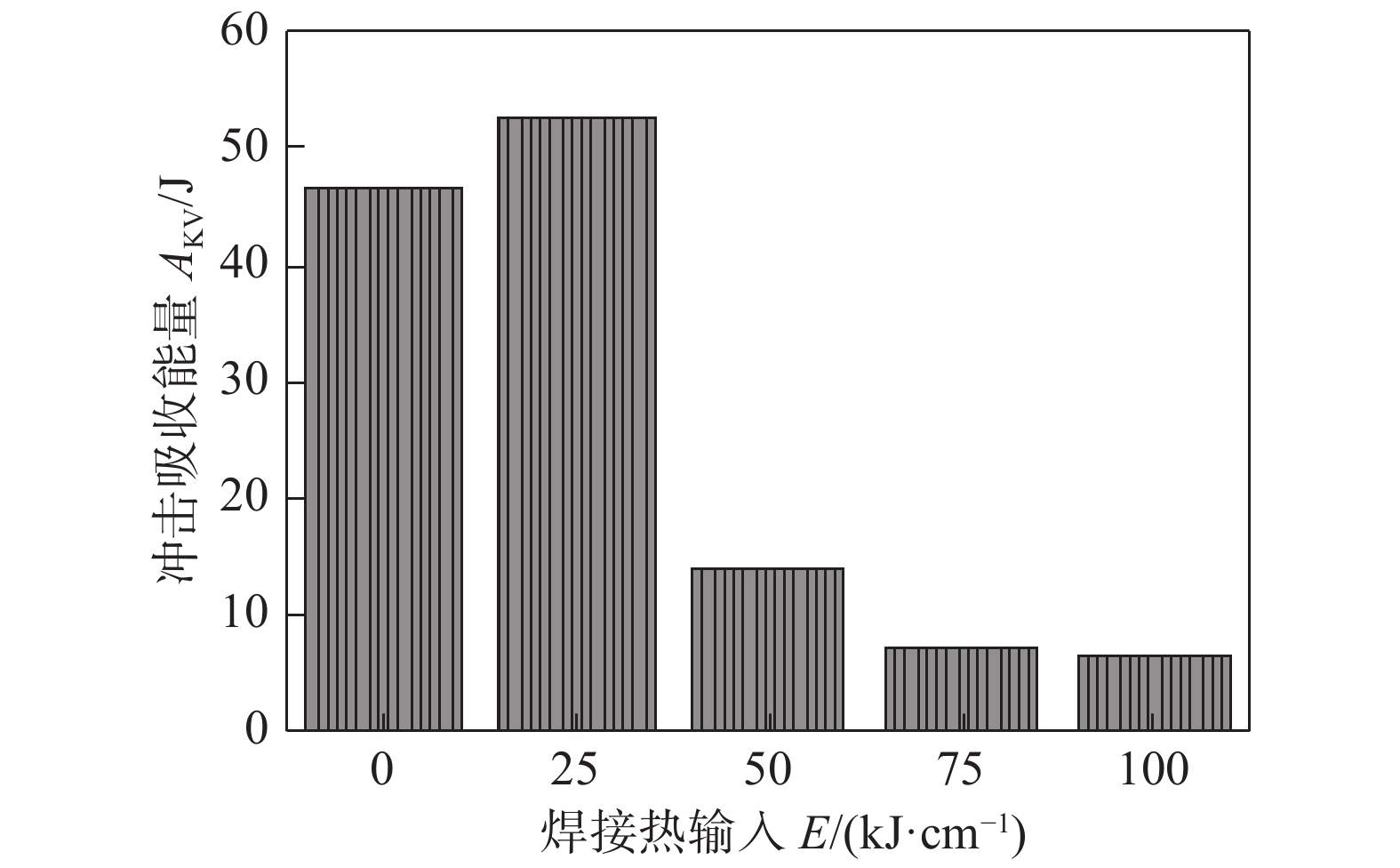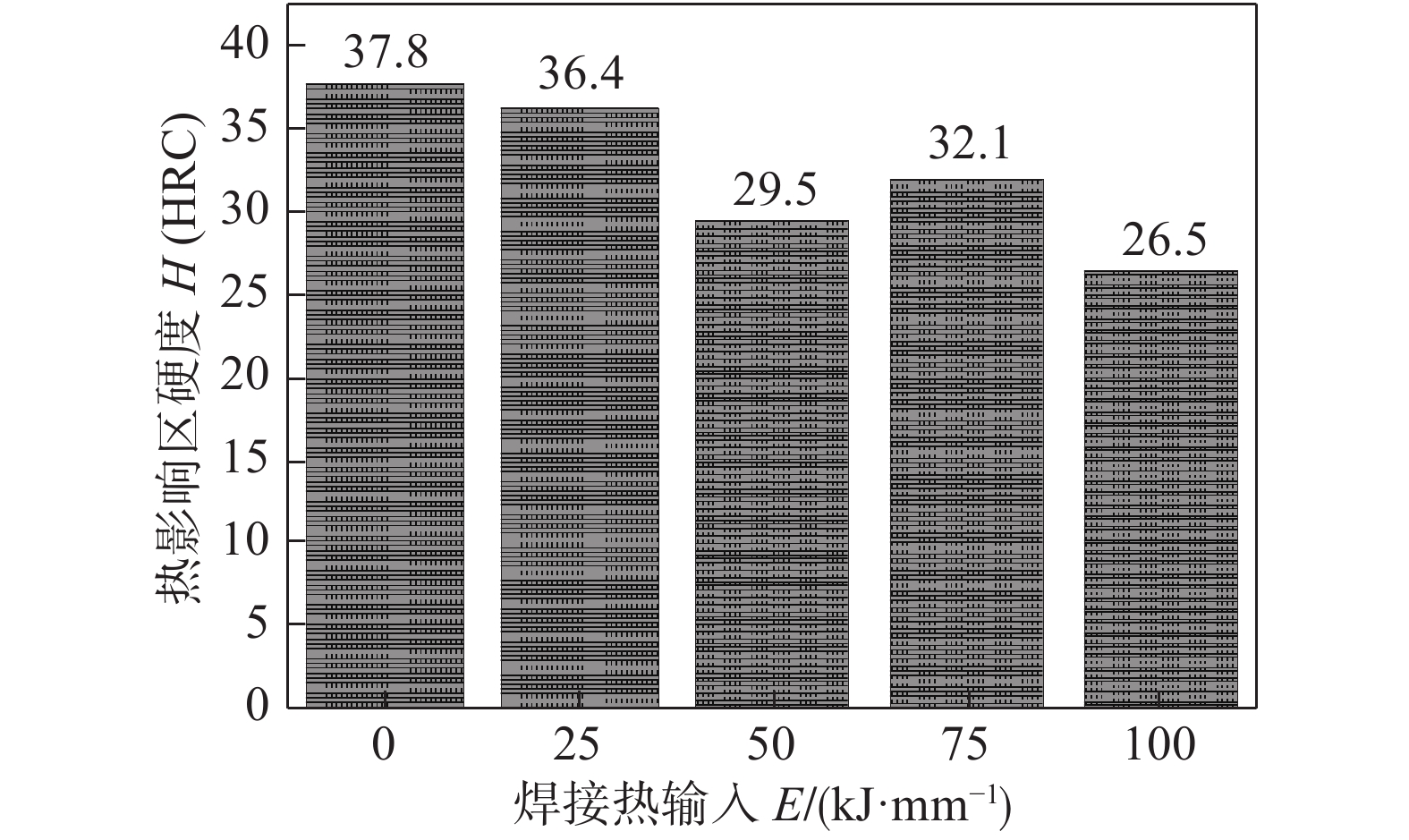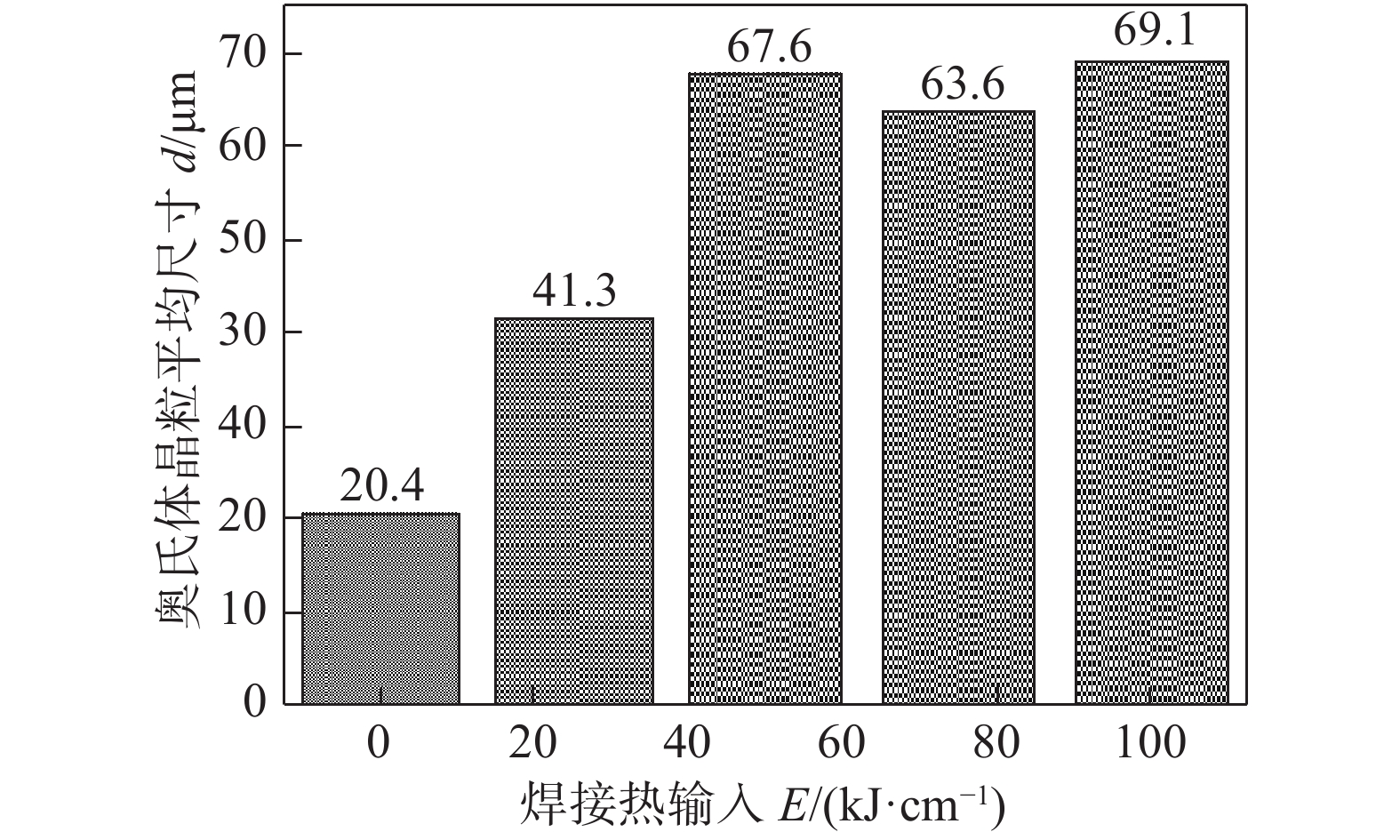Microstructure and properties of heat affected zone of high strength steel with rare earth
-
摘要: 机械装备的整体性能和寿命随着高强钢的大量使用而大幅提高,但性能薄弱区仍然是焊接热影响区. 应用恰当的处理技术,能生成形态、尺寸和分布有益的稀土夹杂物,在焊接中抑制原奥氏体晶粒长大改善钢的焊接性能. 试验制备了一种0.18%C的稀土高强钢,采用Gleeble-3500热模拟机模拟4种热输入下的热循环过程,采用光学显微镜观察了试验钢的焊接热影响区显微组织转变,用冲击试验机测试了焊接热影响区的冲击吸收能量,测量了不同冷却速度下的原始奥氏体晶粒尺寸的变化. 结果表明,焊接热输入值为25 kJ/cm时,HAZ组织主要为马氏体,晶粒尺寸细小,这时的冲击韧性和硬度值最高. 当焊接热输入值大于50 kJ/cm以上时,钢中生成了上贝氏体和粒状贝氏体,晶粒也逐渐长大,出现了韧性下降和软化. 试验钢的C含量为0.18%,在热循环中焊缝中出现了粗大的马氏体组织,形成淬硬组织,未生成针状铁素体组织.Abstract: The overall performance and service life of engineering equipment can be greatly improved for the heavy use of high-strength steel, but it does not change the fact that the weak performance area after welding is still the heat affected zone(HAZ). By the proper rare earth treatment technology, not only the rare earth inclusions with beneficial morphology, size and distribution can be formed in the steel, but also the growth of original austenite grain can be restrained during the welding process. It is actually for these reasons that the welding performance of the steel are boosted.In this study, a kind of 0.18% C high-strength steel with rare earth is produced. The thermal cycling processes under 4 kinds of heat input are simulated by the Gleeble-3500 thermal simulator. The microstructure transformation of HAZ is observed by the optical microscope. The impact absorption energy of HAZ is measured by the testing machine. The changes of original austenite grain size under different cooling rates are measured. The results show that when the welding heat input is 25 kJ/cm, the HAZ microstructure is mainly martensite with fine grain size, and then the impact toughness and hardness are the highest level. When the heat input is higher than 50 kJ/cm, the upper bainite and granular bainite are formed, and the grains grow up gradually, resulting in the decrease of both toughness and hardness. The C content of the test steel is 0.18%. During the thermal cycle the coarse martensite structure appears, forming the harden structure without the acicular ferrite structure.
-
Keywords:
- high strength steel /
- rare earth /
- welding heat affected zone /
- microstructure /
- properties
-
0. 序言
随着科技进步和经济的发展,高强钢的应用领域不断扩展,需求量增长迅猛. 低合金高强耐磨钢由于合金成本适中、制造技术成熟、加工性能良好,被广泛用于矿山机械、采煤、电力及冶金等行业,逐步用在装载机、挖掘机、采煤刮板输送机、大型矿车等机械的结构件和耐磨件. 高强耐磨钢的应用,加强了装备的薄弱环节,提高了整体寿命. 但因为高强耐磨钢具有较高的强度和硬度,一般屈服强度可达800 ~ 1 500 MPa,高强度等级使得该种钢在焊接时稳定性下降、塑韧性变差、冷裂纹倾向加重,焊接热影响区性能恶化[1-6]. 近年来,稀土在钢中的作用机理研究取得较大进展,实践也证明稀土能改善高强钢的焊接性、低温冲击韧性[7-8],稀土能提高无取向硅钢的磁性能等,这些研究拓展了稀土在钢中的应用[9-12]. 由于焊接的热循环作用,导致粗晶区晶粒粗大,韧性下降,成为整个焊接接头的薄弱区,是高碳当量高强钢焊接接头裂纹及脆性破坏的多发部位[13-15],稀土元素在钢中适量添加,改善了晶界结构和焊接性能,可发挥独特作用[16].
文中开发了一种提高焊接性能的稀土氧化物冶金技术(enhanced welding properties via rare earth oxide metallurgy technology,EW-REOMT),从母材要素入手,控制钢中氧化物的形态,使其尺寸细化并弥散分布,在焊接过程中起到阻止奥氏体晶粒长大,提高钢的焊接热影响区(HAZ)冲击吸收能量,改善高强度钢板焊接性能, 可加大热输入,提高焊接生产效率,对推广普及机器人焊接意义深远[17].
1. 试验方法
试验材料为含稀土高强耐磨钢板,化学成分(质量分数,%)为:C 0.18,Si 0.25,Mn 1.33,Cr 0.55,Ni 0.13,Mo 0.17,S 0.001,P 0.010,Nb 0.020,N 0.0031,Ca 0.001,Al 0.024,Ce 0.0020,Fe余量. 金相组织如图1.
1.1 模拟焊接热影响区组织和性能
将待模拟试样加工成75 mm × 10.5 mm × 10.5 mm,使用Gleeble3500热模拟机,按Rykalin-2D模型模拟试验钢的焊接热循环过程,热输入分别为25,50,75 和100 kJ/cm,试验参数见表1.
用光学金相显微镜观察模拟后试样的显微组织,测量其原始奥氏体晶粒尺寸,测定不同焊接热输入模拟条件下各试样的室温V形冲击吸收能量和焊接热影响区的HRC硬度.
表 1 焊接热循环试验工艺参数Table 1. Thermal cycle test parameters for welding热输入
E/(kJ·cm−1)最高加热温度Tmax/℃ 高温停留时间tH/s 冷却时间t8/5/s 25 1350 1 18 50 1350 1 74 75 1350 1 165 100 1350 1 295 2. 试验结果
2.1 CCT 曲线
经不同冷却速度的热模拟试验,测定高强钢的CCT曲线,见图2.
在0.5 ~ 50 ℃/s的冷却速度范围内,随着冷却速度(CR)的增加,组织由少量多边形铁素体(QPF)、上贝氏体(UB)、下贝氏体(LB)、粒状贝氏体(GB)和马氏体(M)组成.
当冷却速度由0.5 ℃/s增加至1 ℃/s时,多边形铁素体(QPF)不断减少,直至消失,贝氏体的含量不断增加. 当冷却速度处于1 ~ 7.5 ℃/s时,钢中组织全为贝氏体组织,冷却速度越大,钢中下贝氏体(LB)组织比例越大,粒状贝氏体(GB)组织越少. 冷速继续增大,钢中贝氏体(B)占比减少,开始出现马氏体(M)组织. 冷却速度为25 ℃/s时,钢中全部生成了马氏体组织.
2.2 焊接热影响区组织
观察试样热模拟试验后的OM显微组织转变过程,如图3所示. 在焊接热影响区范围内,当冷却速度为0.5 ℃/s时,HAZ的组织主要为粒状贝氏体(GB)和少量多边形铁素体(QPF);当冷却速度增加到1 ℃/s时,组织主要为粒状贝氏体(GB),多边形铁素体和少量上贝氏体(UB);当冷却速度增加至2 ℃/s时,组织主要为粒状贝氏体(GB)和上贝氏体组织(UB),且随着冷却速度的增加,上贝氏体组织也逐渐增加;冷却速度增加到7.5 ℃/s,钢中开始出现下贝氏体组织(LB);继续增大冷却速度(图4),钢中开始出现马氏体(M). 当冷却速度达到25 ℃/s,HAZ下贝氏体组织基本消失,此时均为马氏体组织(M).
图5为不同焊接热输入条件下显微组织.图4a是试验钢母材组织马氏体(M). 焊接热输入为25 kJ/cm时HAZ组织主要为马氏体(M),并含有少量下贝氏体(LB). 焊接热输入为50 kJ/cm时HAZ出现了上贝氏体(UB)组织,以及部分粒状贝氏体(GB). 进一步增加焊接热输入至75 ~ 100 kJ/cm,HAZ组织类型未变化,但粒状贝氏体所占比例有所增加.
2.3 焊接热影响区力学性能
钢材的冲击韧性主要与组织类型、晶粒尺寸、夹杂物或析出相的种类、分布、数量和尺寸等有关. 在焊接过程中,由于HAZ经历了快速加热、高温停留及冷却过程,组织和性能会发生变化,使得HAZ成为焊接结构件韧性的薄弱区.
不同焊接热输入条件下,V形夏比冲击吸收能量(20 ℃)如图6所示. 不同焊接热输入焊接热影响区的硬度见图7.
当焊接热输入为0和25 kJ/cm时,试样HAZ硬度较高;进一步增加焊接热输入,HAZ硬度降低. 焊接热输入对HAZ冲击韧性和硬度的影响趋势一致.
2.4 焊接热影响区原始奥氏体晶粒
不同焊接热输入试样原始奥氏体晶粒的平均尺寸如图8.焊接热输入为0 kJ/cm时,原奥氏体晶粒尺寸大多数分布在10 ~ 30 μm,平均尺寸为20.4 μm. 当焊接热输入值增加至25 kJ/cm时,HAZ原奥氏体晶粒尺寸明显增加,以20 ~ 50 μm为主,平均尺寸为41.3 μm. 当焊接热输入值为50 kJ/cm时,HAZ原奥氏体晶粒尺寸继续增加,主要分布在50 ~ 90 μm,平均尺寸为67.6 μm. 继续增加焊接热输入至75 和100 kJ/cm时,HAZ原奥氏体晶粒的平均尺寸增加幅度趋缓.
3. 分析讨论
3.1 焊接热影响区韧性下降及软化
试验钢在焊接热循环过程中,HAZ在高温区域会停留一段时间,HAZ过热区的温度将达到1 350 ℃左右,奥氏体晶粒由于过热严重粗化,甚至发生局部软化和脆化的现象,粗大的晶粒会导致其冲击韧性下降.通过分析热模拟后HAZ组织与性能,焊接热输入为0 ~ 25 kJ/cm时,HAZ冲击韧性和硬度值最高,HAZ组织为马氏体和少量下贝氏体,而且晶粒尺寸相对细小. 当焊接热输大于50 kJ/cm时,钢中生成了上贝氏体、粒状贝氏体,且晶粒也逐渐长大,结果极大地降低了HAZ冲击韧性. 同时,HAZ硬度也下降,导致试验钢HAZ出现软化现象. 因此,在实际应用中对高强耐磨钢焊接接头组织与性能的控制非常重要.
3.2 热影响区中无针状铁素体
大量研究表明,HSLA钢的焊缝力学性能与焊缝组织密切相关,针状铁素体(AF)的增加,焊缝的强度和韧性均提高.试验用钢即使冷却速度减小到0.5 ℃/s,钢中仍未生成针状铁素体组织,这是因为AF是中温转变产物,在650 ~ 500 ℃之间形成,一般碳含量控制在0.05% ~ 0.15%范围,随着碳当量的增加,焊缝中出现了粗大的马氏体组织,易形成淬硬组织,试验用钢碳含量为0.18%,不具备诱导针状铁素体的条件,焊后组织多为马氏体和贝氏体组织.
4. 结论
(1)试验钢添加了20×10−6稀土Ce,使用Gleeble 3500焊接热模拟机模拟了4种热输入下的热循环,焊接热输入值为25 kJ/cm时,HAZ冲击韧性和硬度值最高,当焊接热输入值大于50 kJ/cm以上时,HAZ出现韧性下降和软化.
(2)焊接热输入值为25 kJ/cm时,HAZ组织主要为马氏体,晶粒尺寸细小. 当焊接热输入值大于50 kJ/cm时,钢中生成了上贝氏体和粒状贝氏体,晶粒也逐渐长大.
(3)热模拟发现,钢中未生成针状铁素体组织,未发挥出钢中稀土夹杂物对焊接的有益作用,这是因为试验钢的C含量为0.18%时,在热循环中焊缝中出现了粗大的马氏体组织,易形成淬硬组织,不具备诱导针状铁素体的条件.
-
表 1 焊接热循环试验工艺参数
Table 1 Thermal cycle test parameters for welding
热输入
E/(kJ·cm−1)最高加热温度Tmax/℃ 高温停留时间tH/s 冷却时间t8/5/s 25 1350 1 18 50 1350 1 74 75 1350 1 165 100 1350 1 295 -
[1] 李少峰, 马成勇, 宋志刚, 等. 800 MPa级高强钢焊接接头组织及力学性能[J]. 焊接学报, 2020, 41(5): 91 − 96. Li Shaofeng, Ma Chengyong, Song Zhigang, et al. Study on the welding joint microstructure and mechanical properties of 800 MPa grade high stress steel[J]. Transactions of the China Welding Institution, 2020, 41(5): 91 − 96.
[2] 张洪涛, 桑健, 王琪晨, 等. TATM700钢等离子-MIG复合焊接工艺[J]. 焊接学报, 2019, 40(12): 25 − 30. Zhang Hongtao, Sang Jian, Wang Qichen, et al. Research on plasma-MIG hybrid welding process of TATM700 steel[J]. Transactions of the China Welding Institution, 2019, 40(12): 25 − 30.
[3] Yang L, Jiang X H, Wang X H. Study on welding process performance of HG70D high strength steel plate[J]. China Welding, 2018, 27(3): 59 − 64.
[4] 张元杰, 彭云, 马成勇, 等. Q890 高强钢焊接淬硬倾向和冷裂纹敏感性[J]. 焊接学报, 2013, 34(6): 53 − 56. Zhang Yuanjie, Peng Yun, Ma Chengyong, et al. Harden quenching tendency and cold cracking susceptibility of Q890 steel during welding[J]. Transactions of the China Welding Institution, 2013, 34(6): 53 − 56.
[5] 苏小虎, 栗卓新, 李红, 等. 高强钢金属芯焊丝E120C-K4熔敷金属粗晶区显微组织对冲击韧性的影响[J]. 焊接学报, 2019, 40(10): 48 − 53. Su Xiaohu, Li Zhuoxin, Li Hong, et al. Microstructure to properties of coarse grained heat affected zone in deposited weld metal of metal cored wire E120C-K4 SU[J]. Transactions of the China Welding Institution, 2019, 40(10): 48 − 53.
[6] 张继魁, 辛莹, 张曼曼. 汽车大梁用低合金高强度钢板的性能与发展[J]. 汽车工艺与材料, 2004(6): 42 − 46. doi: 10.3969/j.issn.1003-8817.2004.06.008 Zhang Jikui, Xin Ying, Zhang Manman. Property and development of high strength low alloy hot rolled steel sheet for truck frame use[J]. Automobile Technology & Material, 2004(6): 42 − 46. doi: 10.3969/j.issn.1003-8817.2004.06.008
[7] 陆斌, 陈芙蓉, 智建国, 等. 应用稀土氧化物冶金技术改善高强钢焊接性能[J]. 金属学报, 2020, 56(9): 1206 − 1216. doi: 10.11900/0412.1961.2020.00052 Lu Bin, Chen Furong, Zhi Jianguo, et al. Enhanced welding properties of high strength steel via rare earth oxide metallurgy technology[J]. Acta Metallurgica Sinica, 2020, 56(9): 1206 − 1216. doi: 10.11900/0412.1961.2020.00052
[8] 安同邦, 田志凌, 单际国, 等. 保护气对 1 000 MPa 级熔敷金属组织及力学性能的影响[J]. 金属学报, 2015, 51(12): 1489 − 1499. doi: 10.11900/0412.1961.2015.00294 An Tongbang, Tian Zhiling, Shan Jiguo, et al. Effect of shielding gas on micrpstructure and performance of 1 000 MPa grade deposited metals[J]. Acta Metallurgica Sinica, 2015, 51(12): 1489 − 1499. doi: 10.11900/0412.1961.2015.00294
[9] 陆斌, 张军, 张文博, 等. 稀土耐磨钢绿色产品设计与研发[J]. 包钢科技, 2019, 45(6): 6 − 9, 17. doi: 10.3969/j.issn.1009-5438.2019.06.003 Lu Bin, Zhang Jun, Zhang Wenbo, et al. Design and research for green products of wear-resistant steel with rare earth[J]. Sci. and Tech. of Baotou steel, 2019, 45(6): 6 − 9, 17. doi: 10.3969/j.issn.1009-5438.2019.06.003
[10] 陈付红, 丁伟, 黄威, 等. 国外先进公司工程机械用高强钢发展现状[J]. 上海金属, 2015(1): 47 − 51. doi: 10.3969/j.issn.1001-7208.2015.01.011 Chen Fuhong, Ding Wei, Huang Wei, et al. Developmet status of foreign high strength steel for engineering machinery[J]. Shanghai Metal, 2015(1): 47 − 51. doi: 10.3969/j.issn.1001-7208.2015.01.011
[11] Lan L, Qiu C, Zhao D, et al. Microstructural characteristics and toughness of the simulated coarse grained heat affected zone of high strength low carbon bainitic steel[J]. Material Science & Engineering: A, 2011, 529(1): 192 − 200.
[12] 张文博, 樊立峰, 陆斌, 等. 稀土La在包钢CSP无取向电工钢 中的应用研究[J]. 包钢科技, 2019, 45(6): 85 − 90. doi: 10.3969/j.issn.1009-5438.2019.06.021 Zhang Wenbo, Fan Lifeng, Lu Bin, et al. Application research on rare earth La in CSP non-oriented electrical steel of Baotou steel[J]. Science and Technology of Baotou Steel, 2019, 45(6): 85 − 90. doi: 10.3969/j.issn.1009-5438.2019.06.021
[13] Kim S, Kang D, Kim T W, et al. Fatigue crack growth behavior of the simulated HAZ of 800 MPa grade high-performance steel[J]. Material Science & Engineering: A, 2011, 528(6): 2331 − 2338. doi: 10.1016/j.msea.2010.11.089
[14] Lambert-Perlade A, Gourgues A F, Pineau A. Austenite to bainite phase transformation in the heat-affected zone of a high strength low alloy steel[J]. Acta Mater, 2004, 52(8): 2337 − 2348. doi: 10.1016/j.actamat.2004.01.025
[15] Shome M, Gupta O P, Mohanty O N. Effect of simulate thermal cycles on the microstructure of the heat-affected zone in HSAL-80 and HSLA-100 steel plates[J]. Metallurgical and Materials Transactions A, 2004, 35(3): 985 − 996. doi: 10.1007/s11661-004-0025-8
[16] 王龙妹, 稀土在低合金及合金钢中的应用[M].北京: 冶金工业出版社, 2016. Wang Longmei.Applcation of rare earth in low alloy and alloy steel[M]. Beijing: Metallurgical Industry Press, 2016.
[17] 余圣甫, 杨可, 雷毅, 等. 大热输入焊接高强度低合金钢热影响 区的晶粒细化[J]. 焊接学报, 2008, 29(3): 17 − 19. doi: 10.3321/j.issn:0253-360X.2008.03.005 Yu Shengfu, Yang Ke, Lei Yi, et al. Grain refinement of heat affected zone of high strength low alloy steel by large heat input welding[J]. Transactions of the China Welding Institution, 2008, 29(3): 17 − 19. doi: 10.3321/j.issn:0253-360X.2008.03.005
-
期刊类型引用(0)
其他类型引用(2)




 下载:
下载:







